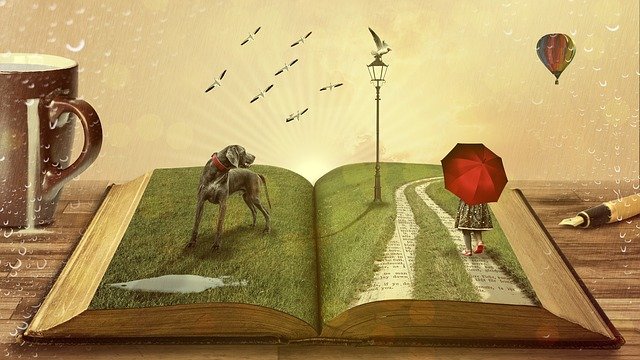10 Storytelling Tricks For Fiction Writing

The difference between telling a story and storytelling is simple. Telling a story relates the facts to your reader, but storytelling makes a tale come alive.
Below you’ll find 10 tricks to help you incorporate storytelling techniques into your writing at every stage of the process.
First Things First: Pace Yourself
1. Identify key moments
Before you write a scene, take the time to think about the key moments that need to occur. Make a list of both emotional and action based moments. This will keep you focused on the elements of your plot and make it clear where and when you can add storytelling to enhance these crucial points.
2. Save the best for last
Now that you have a list of key moments, make sure that you are saving the most impactful moment for the final part of the scene. This doesn’t need to be a cliffhanger, but it should be the most important part of the scene – where you reveal something that drives your plot forward. Placing this information at the end of a scene keeps the reader interested, and gives you a good rule of thumb by which to structure your storytelling.
Next Fill In the Gaps: Get Physical
3. Build your stage
Think about your scene as a play. Too often as authors we can be so focused on our character interactions that we forget to build a set around them. With each scene, you need to convey where your characters are to give the reader a foothold in their world. This means you need to name a location and/or give a few details as to what the place looks like.
4. Check your 5 senses: Sight, Touch, Taste, Hearing, Smell
Barring alien life forms or disabilities, our characters are experiencing the world with their whole body. Bring your stage to life by having your character remark on their surroundings via their five senses.
For example: a heroine could note that the roses her lover sent smell rich and heavy, like springtime. This gives the reader a chance to experience the gift vicariously. On the other hand, bringing in the senses could allow a detective to see his suspect’s eyes twitch to the left, signaling to the reader that our suspect is lying, without the dialogue.
Checkpoint: Watch the Details
5. Note the mundane
What time of year is it? In writing a scene, it is important to remember to relay seemingly mundane information to the reader. Not only does give a fuller picture of your scene, knowing that it is the middle of winter shows that it really must be love if our hero runs outside in a t-shirt to beg forgiveness from our heroine.
6. Does anyone want a drink?
This is another reminder that characters are people too. They’re going to eat, drink, and excuse themselves to go to the bathroom. Now, we don’t necessarily need to see the characters eat three square meals a day – but we can use food, wine, and the call of nature to build our story.
For example: describing Thanksgiving dinner by saying you ate turkey and pie is underwhelming. Try to include details, like how the pumpkin pie had a dollop of fluffy whipped cream on top. Make the audience’s mouth water – it will make the readers feel as though they are in the scene.
Food and drink can be used for purposes beyond tantalizing taste buds. Taking a sip of wine in the middle of a conversation is a good way to express that character is stalling for time and having a character go to the bathroom in the middle of a road trip gives the sense that a long time has passed. Common necessity is a great way to build your stage as well as give information without having to explicitly state it.
7. WWXD
“What Would X Do?” The key to telling a good story is to stay true to your characters. It would be nice if the Editor of the High School Newspaper was able to deduce who cheated on the test with fingerprint analysis, computer hacking skills, or telepathy. But unless your character is at a special magnet school for criminology, a tech geek, or has paranormal abilities – they have to solve the crime the old fashioned way: gossip and maybe the assistance of a teacher or two.
It’s tempting to aide our characters when we want them to succeed or to kill them off when we start to dislike them. Still, the truth is, good storytelling happens when your character lives within the personality, and the world you’ve created.
Finally: Major Elements to Note
8. Cause = Effect
Bear with me here…this one is tough. Cause happens and then we see an effect. If we forget to set a kitchen timer for our cookies, they’ll come out of the oven burnt. I know, this seems simple enough, but we often forget to proceed in this orderly fashion. Sometimes our protagonist has burnt cookies and we’ve forgotten to tell the audience why.
An example: “Sam pulled the charred cookies out of the oven, thinking Susie would never want to go to prom with him now.” While we’ve gotten our point across (the state of Sam’s prom-posal is in jeopardy!), our readers are thinking… “Wait, how did the cookies get burnt?” Small (or large) slips like this pull the audience out of the story and hurt the flow of your tale.
9. Tension is your driving force
Readers keep reading because of unmet desires. Good storytelling instills in the reader an intention to keep reading; to find out what happens next. As an author you need to keep building tension to maintain that desire.
10. Just Trust Me
The keystone of storytelling is trust. You get to build your world using storytelling techniques. In the act of reading your story, the audience gives you their trust – it’s your job not to break it. So no matter if it’s a big plot twist or a small detail, it needs to belong in the world you’ve created.
An example: let’s use vampires. One of the tenets of world building with vampires is addressing the issue of sunlight. Are your vampires sparkly, sunlight safe vampires? Or are your vampires going to disintegrate into a pile of ashes with the first rays of the dawn?
Either instance is believable to readers, but if you say that your vampires are allergic to the sun, you can’t negate that – even if the vampire really, really wants to have brunch outside with the heroine. Breaking the rules of your world will not only pull readers out of your storytelling spell – you’re going to kill the world of the book for them too.





